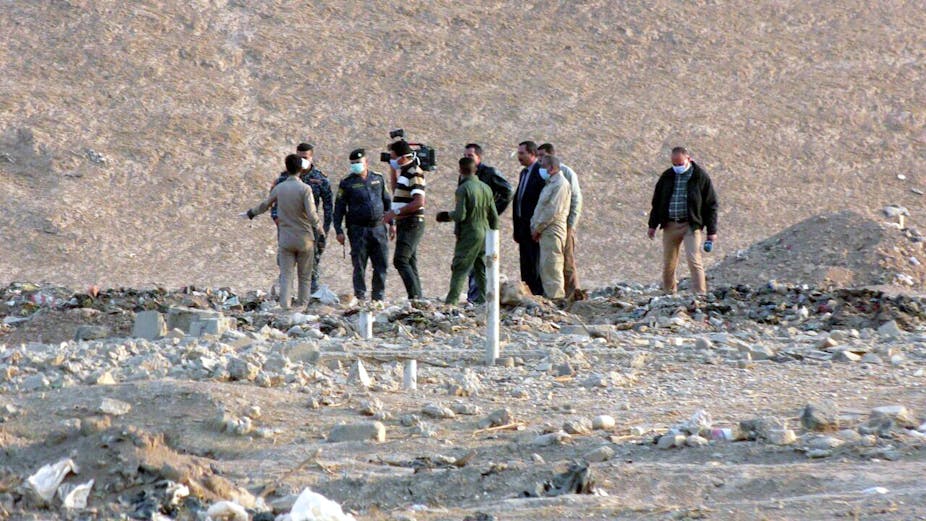In the middle of the ongoing battle to take the Iraqi city of Mosul back from Islamic State (IS) fighters, Iraqi forces located mass graves south of the city. One had an estimated 100 decapitated bodies and another two mass graves were found inside a well with around 250 bodies. Sadly, such sites have become a familiar occurrence in this region of the world.
A study published in August 2016 by Associated Press revealed that 72 mass graves have been located in Iraq and Syria as a result of the occupation by IS. The estimated number of bodies inside them ranges from 5,200 to 15,000.
Sites of mass graves have been discovered all around the world. Decades after conflicts have ended, countries including Cambodia, Bosnia and Kosovo are continuing to grapple with their legacy.
While there have been calls from some European parliamentarians for mass graves in Iraq and Syria to be protected, implementing adequate safeguarding has yet to become a priority for the international community.
Key for truth and justice
There are compelling reasons for why mass graves need to be protected. They hold evidence that is important for the criminal investigations needed to bring perpetrators to justice. At the same time, the families of the dead have a need and right to know what happened to their loved ones. This requires identification and repatriation of the bodies. All too often, mass graves are disturbed and contaminated, compromising these ends.
A 2016 Human Rights Watch report drew attention to disturbed mass graves around Mount Sinjar in Northern Iraq. Precious evidence for future prosecutions of what might constitute genocide against the Yazidi people is at risk. This is significant, particularly if a campaign for the International Criminal Court to open a preliminary investigation into the matter is successful.

There is currently no international legal protection specifically for mass graves. This gap needs to be filled by guidelines that are of practical use to state actors, armed groups, occupying forces, civil society and specialist agencies.
Meanwhile, various parts of both the laws of armed conflict and those regarding international human rights contain some legal provisions. For example, the Protocol Additional to the Geneva Conventions demand the protection of grave sites. Such laws put the onus on states to undertake continued and systematic efforts to investigate abuses. This means a duty to gather the evidence in an attempt to answer questions about what happened and why it happened, while identifying those responsible, directly and indirectly, and any patterns of abuse.
Protection needed
Given that mass graves are often a primary source of evidence for an atrocity, the preservation of such sites is pivotal when it comes to prosecuting those responsible for human rights violations.
Iraq is a case in point. With the support of the International Commission on Missing Persons (ICMP), Iraq enacted a law in 2006 solely dedicated to the protection of mass graves. Yet the effectiveness of this law has been undermined by a lack of implementation from within Iraq and support from the international community. This inaction resulted in UN criticism in 2015, which called on the Iraqi government to ensure the protection of mass graves and the international community to assist in the protection as well as excavation processes.
Since then, there has been some progress. The ICMP, which signed a cooperation agreement in July 2016 with the Office of the Prosecutor of the International Criminal Court, has been active in Iraq since 2003. In March 2016, it began to install fences around known mass grave sites in Mount Sinjar, Northern Iraq, marked with a sign warning against entry and providing a contact telephone number for anyone wishing to provide information.
Once a mass grave is discovered, there are a number of crucial steps that should be taken by all those involved to make sure that successful prosecutions and identification efforts can follow. The needs of victims and the interest of justice demand it. A key part of this is to ensure those mass graves that require security protection and other assistance, such as support with scientific excavations, psycho-social family liaison, identification and repatriation efforts, receive it.
Legal protection of such mass graves would also advance the way in which the wider issue of missing persons is addressed, clarifying the obligation of states towards them. This includes the undignified treatment of dead bodies of refugees and asylum seekers, more and more of whom are losing their lives on their journey to safety due to a lack of legal channels to cross borders and apply for asylum.
A recent study has started to set out the international legal framework for the protection of dead bodies of refugees and asylum seekers. But there is still much work to be done to ensure that dead bodies and the sites in which they have been discovered are preserved with respect.

